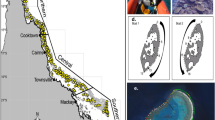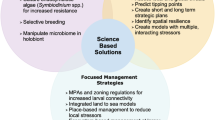Abstract
Detritivore sea cucumbers appear to have been abundant on historic tropical reefs, but (1) have been heavily exploited since at least the mid-1800s, (2) often show minimal recovery post-harvest, and (3) are relatively depleted from modern marine communities. Because they were more abundant, fed on bacteria, microalgae, and other organics, and processed tremendous masses of sediments, removing these detritivores from tropical seas may have suppressed removal of sedimentary pathogens, and impacted co-occurring species in ways that are not documented. We conducted enclosure and exclosure experiments of the sea cucumber Holothuria atra in a back reef lagoon in Moorea, French Polynesia and found that excluding this sea cucumber increased a measure of sediment surface pigmentation by about 10 × but also decreased the potency of extracts from a co-occurring coral (Acropora cytherea) against the heat-activated coral pathogen Vibrio coralliilyticus by a significant 52%. This suggests that the large-scale removal of detritovores from shallow tropical seas may make some co-occurring foundation species more susceptible to pathogens during periods of elevated temperatures or other stresses.



Similar content being viewed by others
References
Allgeier JE, Burkepile DE, Layman CA (2017) Animal pee in the sea: consumer-mediated nutrient dynamics in the world’s changing oceans. Glob Chang Biol 23:2166–2178
Anderson SC, Flemming JM, Watson R, Lotze HK (2011) Serial exploitation of global sea cucumber fisheries. Fish Fish 12:317–339
Bakus GJ (1968) Defensive mechanisms and ecology of some tropical holothurians. Mar Biol 2:23–32
Beatty DS, Valayil J, Clements CS, Ritchie K, Stewart FJ, Hay ME (2019) Variable effects of local management on coral defenses against a thermally regulated bleaching pathogen. Sci Adv 5(10):eaay1048
Boyero L, López-Rojo N, Tonin AM, Pérez J, Correa-Araneda F, Pearson RG, Bosch J (2021) Impacts of detritivore diversity loss on instream decomposition are greatest in the tropics. Nat Commun 12:3700
Clements CS, Hay ME (2019) Biodiversity enhances coral growth, tissue survivorship and suppression of macroalgae. Nat Ecol Evol 3:178–182
Conand C (1990) The fishery resources of the Pacific island countries, Part 2. Holothurians. FAO Fish Tech Pap 272:2
Eriksson H, Friedman K, Amos M, Bertram I, Pakoa K, Fisher R, Andrew N (2017) Geography limits island small-scale fishery production. Fish Fish 19:308–320
Estes JA, Terborgh J, Brashares JS, Power ME, Berger J, Bond WJ, Carpenter SR, Essington TE, Holt RD, Jasckson JBC, Marquis RJ, Oksanen L, Oksanen T, Paine RT, Pikitch EK, Ripple W, Sandin SA, Scheffer M, Schoener TW, Shurin JB, Sinclair ARE, Soule ME, Virtanen R, Wardle DA (2011) Trophic downgrading of planet Earth. Science 333:301–316
Genin A, Levy L, Sharon G, Raitsos DE, Diamant A (2020) Rapid onset of warming events trigger mass mortality of coral reef fish. Proc Nat Acad Sci USA 117:25378–25385
Harvell CD, Mitchell CE, Ward JR, Altizer S, Dobson AP, Ostfeld RS, Samuel MD (2002) Ecology, climate warming and disease risk for terrestrial and marine biota. Science 296:2158–2162
Harvell CD, Montecino-Latorre D, Caldwell JM, Burt JM, Bosley K, Keller A, Heron SF, Salomon AK, Lee L, Pontier O, Pattengill-Semmens C, Gaydos JK (2019) Disease epidemic and a marine heat wave are associated with the continental-scale collapse of a pivotal predator (Pycnopodia helianthoides). Sci Adv 5:eaau7042
Hughes TP, Anderson KD, Connolly SR, Heron SF, Kerry JT, Lough JM, Baird AH, Baum JK, Berumen ML, Bridge TC, Claar DC, Eakin CM, Gilmour JP, Graham NAJ, Harrison H, Hobbs J-PA, Hoey AS, Hoogenboom M, Lowe RJ, McCulloch MT, Pandolfi JM, Pratchett M, Schoepf V, Torda G, Wilson SK (2018) Spatial and temporal patterns of mass bleaching of corals in the Anthropocene. Science 359:80–83
Jackson JBC, Kirby MX, Berger WH, Bjorndal K, Botsford LW, Bourque BJ, Bradbury RH, Cooke R, Erlandson J, Estes JA, Hugher TP, Kidwell S, Lang CB, Lenihan HS, Pandolfi JM, Peterson CH, Steneck RS, Tegner MJ, Warner RR (2001) Historical overfishing and the recent collapse of coastal ecosystems. Science 293:629–638
Kinch J, Purcell J, Uthicke S, Friedman K (2008) Population status, fisheries and trade of sea cucumbers In the western Central pacific. In: Toral-Grande V, Lovatelli A, Vasconcellos M (Eds) Sea cucumbers: a global review of fisheries and trade.FAO Fisheries and Aquaculture Technical Paper # 516. Rome, FAO. Pp. 7–55.
Lamb JB, Van De Water JAJM, Bourne DG, Altier C, Hein MY, Fiorenza EA, Abu N, Jompa J, Harvell CD (2017) Seagrass ecosystems reduce exposure to bacterial pathogens of humans, fishes, and invertebrates. Science 355:731–733
Lawrence JM (1979) Numbers and biomass of the common holothuroids on the windward reef flat at Enewetak atoll. In: Echinoderms Present and Past. Edited by M. Jangoux. Rotterdam, Balkema, pp. 201–204
Lee S, Ford AK, Mangubhai S, Wild C, Ferse SCA (2018) Effects of sandfish (Holothuria scabra) removal on shallow-water sediments in Fiji. PeerJ 6:e4773. https://doi.org/10.7717/peerj.4773
Myers RA, Baum JK, Shepherd TD, Powers SP, Peterson CH (2007) Cascading effects of the loss of apex predatory sharks from a coastal ocean. Science 315:1846–1850
Moriarty DJW (1982) Feeding of Holoturia atra and Stichopus chloronotus on bacteria, organic carbon and organic nitrogen in sediments of the Great Barrier Reef. Aust J Mar Freshw Res 33:255–263
Moriarty DJW, Pollard PC, Hunt WG, Moriarty CM, Wassenberg TJ (1985) Productivity of bacteria and microalgae and the effect of grazing by holothurians in sediments on a coral reef. Mar Biol 85:293–300
Power ME, Tilman D, Estes JA, Menge BA, Bond WJ, Mills LS, Daily G, Castilla JC, Lubchenco J, Paine RT (1996) Challenges in the quest for keystones. Bioscience 46:609–620
Purcell SW, Mercier A, Conand C, Hamel J-F, Toral-Granda MV, Lovatelli A, Uthicke S (2013) Sea cucumber fisheries: global analyses of stock, management measures and drivers of overfishing. Fish Fish 14:34–59
Purcell SW, Conrad C, Uthicke S, Byrne M (2016) Ecological roles of exploited sea cucumbers. Oceanogr Mar Biol Annu Rev 54:367–386
Richmond R (1997) Reproduction and recruitment in corals: critical links in the persistence of reefs. In C. Birkeland (Ed.), Life and death of coral reefs (pp. 175–196). New York: Chapman and Hall
Ripple WJ, Estes JA, Beschta RL, Wilmers CC, Ritchie EG, Hebblewhite M, Berger J, Elmhagen B, Letnic M, Nelson MP, Schmitz OJ, Smith DW, Wallach AD, Wirsing AJ (2014) Status and ecological effects of the world’s largest carnivores. Science 343: Article number 1241484. https://doi.org/10.1126/science.1241484
Seale A (1911) The fishery resources of the Philippine Islands. Part IV, miscellaneous marine products. Philipp J Sci 6:283–289
Stein A (2018) Development and application of sea cucumber fishery regulations in French Polynesia. SPC Fisheries Newsletter 157:40–59
Steneck RS, Bellwood DR, Hay ME (2017) Herbivory in the marine realm: shaping ecosystems and colliding with the Anthropocene. Curr Biol 27:R484-489
Taylor BW, Flecker AS, Hall RO (2006) Loss of a harvested fish species disrupts carbon flow in a diverse tropical river. Science 313:833–836
Uthicke S (1999) Sediment bioturbation and impact of feeding activity of Holothuria (Halodeima) atra and Stichopus chloronotus, two sediment feeding holothurians, at Lizard Island, Great Barrier Reef. Bull Mar Sci 64:129–141
Uthicke S (2001) Interactions between sediment-feeders and microalgae on coral reefs: grazing losses versus production enhancement. Mar Ecol Prog Ser 210:125–138
Uthicke S, Welch D, Benzie JAH (2004) Slow growth and lack of recovery in overfished Holothurians on the Great Barrier Reef: evidence from DNA fingerprints and repeated large-scale surveys. Conserv Biol 18:1395–1404
Wolfe K, Vidal-Ramirez F, Dove S, Deaker D, Byrne M (2018) Altered sediment biota and lagoon habitat carbonate dynamics due to sea cucumber bioturbation in a high-pCO2 environment. Glob Chang Biol 24:465–480
Acknowledgements
Financial support came from U.S. National Science Foundation Grant OCE 1947522, the National Geographic Society (Grant No. NGS-57078R-19), the Teasley Endowment, and the Anna and Harry Teasley Gift Fund. This work represents a contribution of the Moorea Coral Reef (MCR) LTER Site supported by U.S. National Science Foundation Grant OCE 16-37396. We thank the French Polynesian Government (Délégation à la Recherche) and the Haut-commissariat de la République en Polynésie Française (DTRT) for relevant permits (Protocole d'Accueil 2017–2020).
Author information
Authors and Affiliations
Corresponding author
Ethics declarations
Conflict of interest
On behalf of all authors, the corresponding author states that there is no conflict of interest.
Additional information
Publisher's Note
Springer Nature remains neutral with regard to jurisdictional claims in published maps and institutional affiliations.
Topic Editor Steve Vollmer
Rights and permissions
About this article
Cite this article
Grayson, N., Clements, C.S., Towner, A.A. et al. Did the historic overharvesting of sea cucumbers make coral more susceptible to pathogens?. Coral Reefs 41, 447–453 (2022). https://doi.org/10.1007/s00338-022-02227-w
Received:
Accepted:
Published:
Issue Date:
DOI: https://doi.org/10.1007/s00338-022-02227-w




